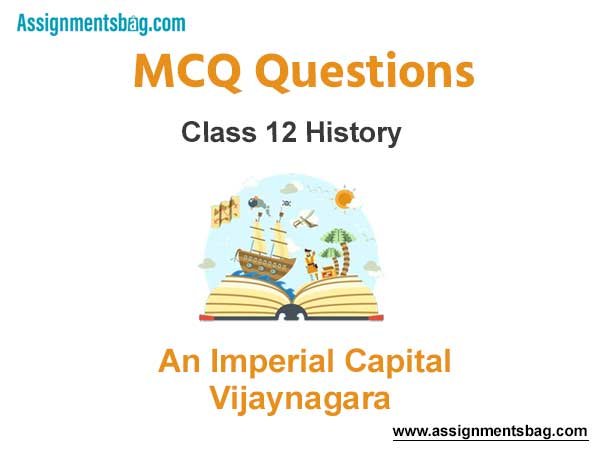Please refer to MCQ Questions Chapter 7 An Imperial Capital: Vijaynagara Class 12 History with answers provided below. These multiple-choice questions have been developed based on the latest NCERT book for class 12 History issued for the current academic year. We have provided MCQ Questions for Class 12 History for all chapters on our website. Students should learn the objective based questions for Chapter 7 An Imperial Capital: Vijaynagara in Class 12 History provided below to get more marks in exams.
Chapter 7 An Imperial Capital: Vijaynagara MCQ Questions
Please refer to the following Chapter 7 An Imperial Capital: Vijaynagara MCQ Questions Class 12 History with solutions for all important topics in the chapter.
MCQ Questions Answers for Chapter 7 An Imperial Capital: Vijaynagara Class 12 History
Question. The military chiefs were called as:
(A) Iqta
(B) Rayas
(C) Nayaks
(D) Chief Minister
Answer
C
Question. Till when did Sangama dynasty rule over Vijayanagara?
(A) 1455 CE
(B) 1485 CE
(C) 1495 CE
(D) 1512 CE
Answer
B
Question. When was the city of Vijayanagara founded?
(A) 1336
(B) 1565
(C) 1800
(D) 1498
Answer
A
Question. Which European company arrived in India 1498 A.D?
(A) The Portuguese
(B) The British
(C) The East India Company
(D) None of the Above
Answer
A
ASSERTION AND REASON BASED MCQs :
Question. Assertion (A): The rulers of the Vijayanagara got built large embankments to store water. They also constructed reservoirs of varying sizes.
Reason (R): They make arrangements to store the rainwater as this was the most arid zone of the peninsula. A very large tank was found built in the fifteenth century to store water. The water of this tank was used for several Royal centre purposes.
(A) Both A and R are true and R is the correct explanation of A.
(B) Both A and R are true but R is NOT the correct explanation of A.
(C) A is true but R is false.
(D) A is false and R is true.
Answer
A
Question. Assertion (A): Temple building in India region had a long history. Pallavas, Chalukyas, Hoysalas, Cholas, all the rulers encouraged temple building.
Reason (R): Temples were developed as religious, social, cultural, economic and learning centre. Shrines of Virupaksha and Pampadevi were very significant sacred centre.
(A) Both A and R are true and R is the correct explanation of A.
(B) Both A and R are true but R is NOT the correct explanation of A.
(C) A is true but R is false.
(D) A is false and R is true.
Answer
B
Question. Assertion (A): The Amara-Nayaka system was a major political innovation of the Vijayanagara empire.
Reason (R): Many features of this system were derived from the iqta system of the Delhi Sultanate. The Amara-Nayakas were military commanders who were given territories to govern by the Rayas or the rulers of Vijayanagara.
(A) Both A and R are true and R is the correct explanation of A.
(B) Both A and R are true but R is NOT the correct explanation of A.
(C) A is true but R is false.
(D) A is false and R is true.
Answer
A
Question. Assertion (A): Many rituals were associated with the Mahanavami Dibba. Hindu Festival Mahanavami or Navaratri were celebrated with great pomp and show in the months of September- October.
Reason (R): All these ceremonies were presented before the king and his guests. On the last day of the festival, the king inspected his army as well as the Nayaks of the army. Through the festival, the rulers of the Vijayanagara Empire displayed their power, prestige, and suzerainty.
(A) Both A and R are true and R is the correct explanation of A.
(B) Both A and R are true but R is NOT the correct explanation of A.
(C) A is true but R is false.
(D) A is false and R is true.
Answer
A
CASE-BASED MCQs :
Question. Observe the picture and answer the following questions by choosing the correct option.

Question. To which historical empire does this stone wall belong to as a boundary to the empire?
(A) Mughal
(B) Mauryan
(C) Vijayanagara
(D) None of these
Answer
C
Question. When was the empire found?
(A) 12th century
(B) 14th century
(C) 16th century
(D) 19th century
Answer
B
Question. What is the other name by which the empire is remembered as?
(A) Stupa
(B) Kalinga
(C) Hampi
(D) Agra
Answer
C
Question. Which of these rivers acts as the natural boundary of this ancient kingdom?
(A) Krishna
(B) Ganga
(C) Mahanadi
(D) Sutlej
Answer
A



